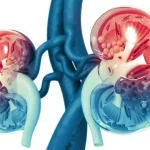This refers to a group of signs and symptoms secondary to glomerular disease.
It encompasses damage to the glomerular capillary wall due to a podocyte pathology, leading to abnormal function or podocyte injury/death.
It increases permeability to plasma proteins, resulting in albumin loss in the urine.

Symptoms
Frothy urine – due to loss of protein in urine (>3 g/24 h)
Oedema (in ankles, periorbital and scrotum) – this occurs secondary to hypoalbuminemia resulting in decreased oncotic pressure
High risk of thrombosis – this is due to loss of endogenous anticoagulants (e.g., antithrombin III) and can give rise to complications including renal vein thrombosis
Hyperlipidemia – increase in lipoprotein synthesis in the liver results in hypercholesterolemia increasing the risk of atherosclerosis
Infection – due to urinary loss of IgG leading to hypogammaglobulinemia
Key tests
Kidney biopsy is the definitive diagnostic step
Management
Definitive treatment is correcting the underlying cause
Supportive management can also be used
Fluid restriction and diuretics – to reduce oedema
Protect renal function with ACEi/ARB
If progresses to end-stage renal failure, patients will need dialysis/transplant
There are many specific conditions which give rise to nephrotic syndrome, which have specific treatments:
Minimal Change disease
This is the most common cause of nephrotic syndrome in children.
Most cases are idiopathic, but it can also be seen in infectious mononucleosis and Hodgkin’s lymphoma.
T cells release cytokines affecting podocyte function which allows the loss of albumin.
However, it usually does not progress to renal failure.
It is highly responsive to steroids, but tacrolimus can also be used.
Causes
Idiopathic (90%)
Associated with Infectious mononucleosis and Hodgkin’s lymphoma
Biopsy findings
Glomeruli look normal under light microscopy (hence minimal change)
Electron microscope shows effacement of foot processes
Management
1st line is Steroid treatment (Prednisolone) – very effective.
2nd line is Immunosuppression e.g tacrolimus
Focal segmental glomerulosclerosis (FSGS)
This is a condition which is more common in adults.
It can be primary or occur secondary to conditions like HIV and sickle cell disease.
It has a poor response to steroids and progresses to chronic renal failure
Causes
Usually idiopathic
Associated with HIV and Sickle cell disease
Biopsy finidngs
Shows focal sclerosis (scarring of glomerulus in parts)
Management
ACE-inhibitors and BP control to slow progression
Steroids for underlying disease
Membranous nephropathy
This is a condition where there is immune complex deposition in the glomerular basement membrane, causing thickening.
It is associated with anti-phospholipase A2 receptor antibodies.
Also, can be secondary to infections (hepatitis B/C) and malignancy.
Causes
Usually idiopathic and associated with anti-phospholipase A2 receptor antibodies
Secondary to infections (Hep B and C)
Cancers
Autoimmune disease (SLE, Rheumatoid)
Biopsy findings
Thickened basement membrane with spike and dome appearance
Management
ACE-inhibitor and blood pressure control to slow progression
Immunosuppression with steroids and chlorambucil
Diabetes mellitus
This is the most common secondary cause of nephrotic syndrome.
High glucose levels cause non-enzymatic glycosylation of basement membrane.
It first causes microalbuminuria and progresses onto chronic renal failure.
Diabetics get annual urinary A: Cr ratio screening to monitor damage to kidneys.
Management
ACE inhibitors slow progression of hyperfiltration-induced damage
Manage diabetes with weight-loss and medications e.g. metformin
Lupus nephritis
Lupus nephritis refers to inflammation of the kidney, which is caused by systemic lupus erythematous, an automimmune disorder.
Since it is a result of SLE, this type of glomerulonephritis is said to be secondary.
The presentation of renal disease in lupus is variable. It can be asymptomatic but also cause a nephrotic or nephritic style disease with rapid progression to renal failure.
Classes of Lupus Nephritis
Class IV (diffuse proliferative) lupus nephritis is the most common and most severe
This causes a nephritic style of disease with haematuria, proteinuria, hypertension peripheral oedema and a rapid deterioration in renal function.
Treatment involves immunosuppression with agents like cyclophosphamide.
Membranoproliferative glomerulonephritis
This is a type of nephrotic syndrome which is not very steroid responsive and leads to gradual renal failure. There are 2 main types:
Immune complex
This is most commonly due to hepatitis C or cryoglobinaemia.
These conditions lead to the formation of immune complexes which get deposited in the glomerulus, giving a classic a tram-track appearance.
C3b glomerulopathy
This occurs due to a defect in the alternative complement pathway.
It is associated with the presence of a C3b antibody (an antibody against C3bBb).
This leads to overactivation of the alternative complement pathway giving inflammation and deposition of immune complexes in the glomerulus.
Biopsy findings
Shows proliferative inflammation and immune complex deposition
Management
ACE-inhibitors and BP control to slow progression
Immunosuppression for underlying disease


